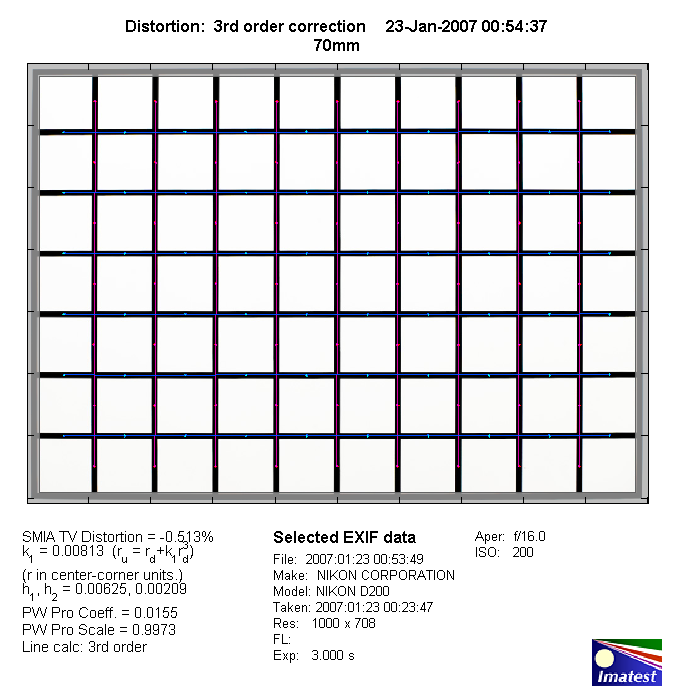|
Nikkor AF-S 70-300mm f/4.5-5.6 G IF-ED VR - Review / Lab Test Report - Analysis |
|
Lens Reviews -
Nikon / Nikkor (APS-C)
|
|
Page 2 of 2
Distortion
Despite its fairly ambitious 4.3x zoom ratio the lens exhibits only slight
barrel distortion at 70mm and slight pincushion distortion towards
the long end of the zoom range.
|
Move the mouse cursor over the focal length text marks below to observe the respective distortion
|
| 70mm |
200mm |
300mm |
|

|
The chart above has a real-world size of about 120x80cm.
Vignetting
The AF 70-300mm is a full frame lens so on an APS-C DSLR it can take
advantage of a sweet spot effect and consequently the lens is capable
to produce image that are almost free of vignetting at all focal lengths
and aperture settings.

MTF (resolution)
The tested sample produced very decent resolution figures under lab conditions.
At 70mm the performance is excellent scratching the resolution limits of the D200
sensor. The drop in quality is only marginal towards the borders of the image frame.
Typical for most tele zoom lenses there's a decrease in performance towards
the long end of the zoom range. At 200mm the results remain on a very high level
whereas at 300mm there´s a significant drop of the border performance. Stopping
down helps to lift the quality of a very good figures by f/11. At wide-open aperture
the contrast level seems to suffer a bit as well.
The field curvature as well as residual spherical aberrations (focus shift when stopping
down) are well controlled.
Please note that the MTF results are not directly comparable across the different systems!
Below is a simplified summary of the formal findings. The chart shows line widths per picture height (LW/PH) which can be taken as a measure for sharpness.
If you want to know more about the MTF50 figures you may check out the corresponding Imatest Explanations
Chromatic Aberrations (CAs)
Lateral chromatic aberrations (color shadows at harsh contrast transitions) are
something of a mixed bag. The lens does not produce the rather hostile
red color CAs but the yellow/blue variant.
At 70mm these CAs are well controlled but at 200mm and more so at 300mm the problem
is quite significant with an average CA pixel width around 2px at the
image borders.

Here´s a sample border portion at 300mm f/11 out-of-the-box. Strong CAs may sound bad
and it really shouldn´t happen but the good news is that the lateral CAs can be
quite easily corrected to a negligible degree. I did it via Photoshop Camera Raw
(blue/yellow fringe = -45) but Nikon Capture NX as well as many other
CA correction tools should work just fine. However, it remains an additional
processing step if needed.
|
Move the mouse cursor over the text marks to switch between the raw and corrected variant
|
| raw CAs |
corrected CAs |
|

|
Verdict
The Nikkor AF-S 70-300mm f/4.5-5.6G IF-ED VR may not be the Über-lens
everybody was hoping for (nor was that realistic) but it is still a very good
lens. At 70mm the results are nothing short of stellar and still easily on a
very good level at 200mm. At 300mm there´s a performance penalty specifically
at the image borders @ f/5.6. Stopping down to f/8 helps to overcome
most of the problems but unfortunately there´s also a quite pronounced but
still correctable degree of yellow/blue (lateral) CA. Distortions
and vignetting are basically non-issues throughout the range.
The build quality is pretty decent and about in line this Nikon's recent
medium grade zoom lenses. The AF is quite fast and almost silent and
unlike most lenses in this league the front-element does not rotate
during focusing nor zooming. The pricing of the lens may be relatively steep
in absolute terms but price/performance-wise it remains a harmonious package.
|